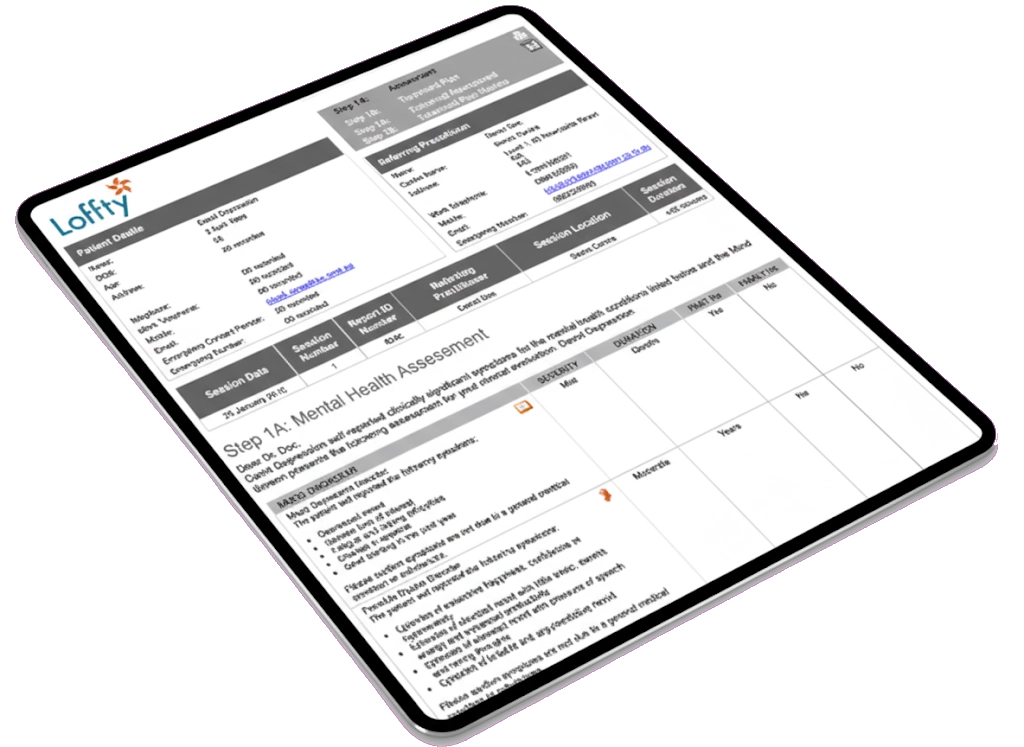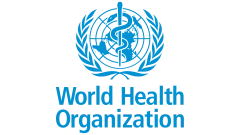
“The Loffty assessment tool was valuable in helping a client to open up on an issue they had been embarrassed to discuss.”
Angela Constantatos, Wellbeing expert
Diagnose and Treat Smarter
Get a head start on treatment by accurately identifying over 30 mental health conditions from the first session.
Build a Stronger Therapeutic Alliance
Deepen your connection with clients by gaining detailed insights that help you focus on what matters most.
Optimise Your Practice
Streamline your workflow to help more people more effectively, improving both your practice's efficiency.
Enhance Your Professional Reputation
Establish yourself as a leader in mental healthcare by consistently achieving better outcomes.


“Loffty gave me a comprehensive report on what was affecting my patient’s state of mind.”
- Dr Chris Mulroney - GP, Melbourne
Register
Click ‘Register’ to become an accredited Loffty practitioner.
Refer
Refer your client to the Loffty website, where they will register and receive their login details.
Review
After finishing their assessment, they will book an appointment to review their Loffty report now available in your dashboard.
Loffty is a decision-support tool—not a diagnostic instrument—and is not a substitute for clinical judgment by health coaches, family doctors, psychologists, psychiatrists or other qualified mental health professionals. By accelerating structured information gathering and highlighting priority domains, the Loffty report enables earlier, more targeted questioning and more efficient clinical evaluation.
Most users complete a Loffty assessment in about 15-30 minutes. Some may be a little faster and some may take longer but there is no time limit to complete your Loffty assessment.
The only requirement for accreditation as a Loffty Practitioner is provision of your practicing credentials, or evidence confirming the professional body you are registered with or accredited to. Loffty can be used by nutritionists, occupational health practitioners, health coaches, mental health coaches, ADHD coaches, general practitioners, psychologist, psychiatrists or any other qualified health professional as long as they operate within their scope of practice and refer appropriately.
Loffty is intended for people aged 16 and over who are genuinely seeking to feel better and are therefore providing truthful answers. Users under 16 may use Loffty with the agreement of a parent or legal guardian.
Yes, Loffty is suitable for clients with limited digital literacy. The assessment is point-and-click/tap with minimal to no typing, and it works on mobile, tablet, and desktop. Items are written at approximately a Year 7 reading level and are compatible with common accessibility tools such as screen readers and text-to-speech. Clients may complete Loffty with assistance from a support person; when doing so, note the helper’s role and avoid leading responses.
What Loffty is (and isn’t).
Loffty is a structured, clinician-supported self-assessment designed to accelerate information gathering and support—rather than replace—clinical judgment. It is not a psychometric test for occupational selection or a generic “personality profile,” and it does not provide diagnoses.
Scope beyond single-disorder tools.
Many legacy instruments target one condition at a time and are often administered on paper. Loffty screens across multiple mental-health domains in a single, coherent workflow, helping you surface potential comorbidities and prioritize lines of inquiry earlier in care.
Decision support you can act on.
Client responses are synthesied into condition-level summaries with severity indicators aligned to contemporary classification frameworks (e.g., DSM-5-TR/ICD-11), giving you a clear starting point for differential considerations, history taking, and targeted measures where needed. You remain responsible for clinical evaluation and any diagnosis.
Efficiency without sacrificing depth.
Because Loffty is electronic and structured, it gathers a wide range of information rapidly and presents it in a format that’s easy to review in session. Many clinicians use the report to focus interviews, confirm key items, and agree on next steps (e.g., psychoeducation, further assessment, referral, or treatment planning).
Consistency and transparency.
Standardised questions and scoring improve reliability compared with ad-hoc intake notes. The report makes the basis for its indicators clear, supporting collaborative discussion with the client and continuity of care across providers.
Designed for real-world accessibility.
The assessment is point-and-click/tap, works on common devices, and is written in plain language to support broad digital and health literacy. Clients can complete it independently or in a supported setting without extensive computer skills.
Integrates with clinical workflow.
Electronic delivery enables additional functionality that paper tools can’t offer—structured summaries, longitudinal comparisons over time, and the ability to revisit specific symptom domains during review.
Limitations and good practice.
As with any self-report measure, outputs reflect the accuracy and completeness of client responses. Use your follow-up consultation to validate key items, clarify discrepancies, and determine whether further standardised measures or specialist assessment are indicated.
Yes, Loffty is designed to be completed online, anywhere your clients feel comfortable.
No, Loffty is a web application, so your clients need to be online to complete their assessment.
Payment is made by your client, using a debit card or credit card, when they register to complete their Loffty assessment. Practitioners are not charged for access to Loffty or for reviewing Loffty reports.
No, Loffty does not display each question-and-answer pair. Rather, it synthesises responses into condition-level summaries and severity indicators informed by DSM-5-TR and ICD-11 criteria. The report is designed as a high-level overview of your client’s mental health and wellbeing to help you focus your consultation, ask clarifying questions, and determine next steps. When a condition is rated mild, moderate, or severe, we recommend reviewing the relevant symptom domains with your client and considering further assessment or referral to reach a diagnosis and treatment plan.
No, your clients' Loffty reports do not get emailed to you. You can access their reports by logging in to your secure Loffty practitioner portal. If you choose to refer to another mental health specialist, you can import their report and forward it via your EMR system so it never needs to be emailed.
The Loffty multi-disorder mental health assessment was originally conceived in 2003 by Dr John Clarkson, a New Zealand-born, Australian-based GP and has been further developed by an interdisciplinary team of mental health professionals in Australia and the USA.
If you can’t log in to your Loffty practitioner portal, please check you have entered your case-sensitive username and password correctly. If you continue having difficulties, please email Loffty Support at helpdesk@loffty.com.
Yes, a Loffty report can be saved as a PDF and imported into practitioners' Electronic Medical Record (EMR) systems.
Save time without sacrificing depth
Efficient reporting in a format that’s easy to review in session. Many practitioners use the Loffty report to focus interviews, confirm key items, and agree on next steps (e.g., psychoeducation, further assessment, referral, or treatment planning).
Reliable and transparent reporting
Standardised questions and scoring improve reliability compared with ad-hoc intake notes. The Loffty report makes the basis for its indicators clear, supporting collaborative discussions with your client or patient.
Integrates with your workflow
Electronic delivery enables additional functionality that other tools can’t offer, including structured summaries, longitudinal comparisons over time, and the ability to revisit specific symptom domains during review.


